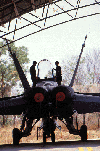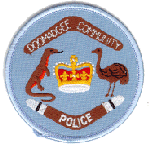
Soaring the Morning Glory, 1990
The Morning Glory ... revisited.
October 1990After a short hop from Camden near Sydney for an overnight stay at Newcastle for my stepmother's 70th, Rob Thompson & I had a longish day in the Grob 109 to Broken Hill, home of the Flying Doctor, where a fellow glider pilot put us up, then on to Uluru where we flew around the Olgas and ridge soared spectacular Mt Connor. The Rock itself is really quite awe inspiring. We could see it on the horizon from almost a hundred miles away, and from the ground it is astonishingly beautiful, really something to which words and photos cannot do justice.
From Yulara, the resort town created to service the tourist industry at the Rock, we cruised up to Alice Springs, then on to Tennant Creek which at night is not a pretty sight. I found it very depressing, but it just hinted at the horrors awaiting us in places like Mornington Island and Doomadgee, up in the Gulf Country. Many locals are tragically addicted to alcohol , and it seems that our society is doing little to address the problem.
Tennant to Tindal was incredibly boring, with nothing but desert as far as the eye could see. Rob & I took turns sleeping. I awoke to Rob telling Darwin control that we were at 8,000 feet 40 miles from Tindal RAAF base, to which they replied we had infringed military controlled airspace, and would pass us on to Tindal control for clearance. Our faces were very red. Darwin didn't let us forget our transgression for days.
We were met on the Tindal strip by a RAAF follow-me vehicle,
which escorted us, not to the civvy parking area as we had expected, but
into the military complex direct to OLA 1, the CO's Hornet hanger. Very
rare for a civvy plane to be accorded this privilege, but I guess they
considered us rather special, a composite glider being the predecessor
of the modern  fighter.
Sailplanes, of course, pioneered glassfibre and all composite aviation
construction, making possible the extraordinary warplanes of this era.
Later, in the ops room, we were shown the bank of videos surveying the
hangars. One had to laugh. Hornet, Hornet, Hornet, Hornet, Grob, Hornet...
fighter.
Sailplanes, of course, pioneered glassfibre and all composite aviation
construction, making possible the extraordinary warplanes of this era.
Later, in the ops room, we were shown the bank of videos surveying the
hangars. One had to laugh. Hornet, Hornet, Hornet, Hornet, Grob, Hornet...
Tindal, near Katherine a few hundred k's south of Darwin, is an oasis. The best of everything. Workshops the size of department stores, capable of stripping and rebuilding an aircraft in days, everyone professional and very fit.
The military is very aware of the threat just over the horizon, 100 or more million Moslems with quite aggressive and corrupt leaders, who, in the event of general hostilities in the Middle East, could quite conceivably have little compunction about attacking their wealthy, and near defenceless, neighbours. East Timor will not be forgotten.
Morale at Tindal is high despite a general sadness due to the loss of 75 squadron's very popular Commanding Officer, Wing Commander Fox, in a recent mid-air - a real life Top Gun; erudite, handsome, and a leader among men. The other pilot survived, and flew home despite the loss of a piece of wing too heavy for two men to lift, dense as concrete and heavy as steel. Quite a robust aircraft. He was flying again, I think, the next day. No blame was apportioned; these men fly at ten tenths, and accidents happen.
Fox crashed nearby Hornet Hill. It took them two days to find his remains, and a cairn is to be erected on the site. The Hornet was consumed by fire, and was interred on the base.
We were loath to leave, as we were given virtually VIP treatment, including use of all facilities for a full service on the Grob and a couple of overdue repairs. Rob hitched up to Batchelor, whilst I flew our gliding buddy and host John (JD) Davis for whom a ride in the motorglider was a real buzz. We were forced to fly through some bushfire smoke so thick we had to descend below a thousand feet just to see the ground, very uncomfortable over such rough country and worrying more-so as we had no idea how far the smoke extended. JD recognised a landmark, allowing us to emerge from the murk almost directly over the glider field at Batchelor where we spent a very laid back weekend with several glider pilots and a host of enthusiastic skydivers.
They say you don't have to be crazy to be a skydiver, but it helps. One chap's wife told us how her husband bounced. His canopy collapsed during a stack, and formed a streamer (or whatever they call it when the canopy tangles with the lines) that began to rotate him at such a velocity that he could not raise his arms to cut free. He impacted at a very acute angle, and did in fact bounce. Later she inspected him minutely for damage. Not a scratch. Not many walk away.
An eerie midnight visit out to the oldest rocks in Australia (and probably the oldest extant) preceded the next day's pleasant and easy flight to Gove on the NW tip of Australia via Jabiru in Kakadu National park, through more enormous bushfires and over many disused WW2 airstrips, then down into the Gulf of Carpentaria and on to Burketown where we rendezvoused with Geoff Sim & Ian Macphee, who had flown up from Lake Keepit near Tamworth in northern NSW in another Grob G109.
We had come to the Gulf to seek once more the Morning Glory, after a tantalising flight in 1989 had revealed to us something of its potential. Our flights of fancy (and some fairly careful calculations) had us hoping to soar 200 km and maybe 7000 feet on a good day. The reality was far beyond our wildest expectations.
Wednesday's first light brought our first Morning Glory, which, to quote from Ray Parkin's Out of The Smoke, ".....was like an immense rolled-up curtain, white on the front curve and black underneath. It came up like a steam-roller." We soared in weak lift above the rollcloud which wasn't particularly well formed, and then experimented well in front of the leading edge discovering much stronger lift sometimes exceeding 4 knots. To the east appeared a huge hump in the inversion, and we penetrated this and soared above it, to 9,500 feet, in a band of lift several kilometres wide.
The sun sparkled on the placid waters of the Gulf as we played with what looked like small lenticulars but which marked only sink, as a mass of stratus-like cloud above us kept pace with the rollcloud beneath, apparently part of the system.
Cloudbase was still a thousand feet or so above us, and we felt that it should be possible to work our way to the front of it, then rise above it into yet another part of the immense system. However, after a couple of time and height consuming attempts to penetrate forward, the lift began to weaken.
Ian & Geoff had turned back with engine problems in HDS shortly after takeoff, overheating initially attributed to the ambient temperature. It was 32 degrees at first light, OAT rising sharply several degrees immediately above the low inversion. When we landed late in the morning they were sitting disconsolately under the wing, the cowls off, tools and rags and bits of aeroplane surrounding them. The motor had gone to lunch. Ian, renowned for his expert and concise phone manner, had been busy on the blower. A new motor from Harry Schneider in Gawler was despatched immediately via Adelaide, Brisbane & Cairns overnight, headed for Doomadgee 100 km southwest of Burketown.
Geoff & Ian flew FFN the following morning to catch a classic twin rotor cloud whilst Rob & I rattled down the most God-awful road we'd ever seen in the Albert Hotel's 4WD Noddy car, 85kph flat stick, and mighty unstable. A Landcruiser full of wallopers barrelled past us just as we entered a large patch of bulldust, gave us a very suspicious once over and left us submerged in an immense brown cloud. Rob copped a lungfull, near choked to death as we ground to a halt completely IMC. He recovered in due course, which was quite a relief as I don't know how I could have explained his demise to his ladyfriend.
 Doomadgee
Mission was quite a startling experience for city boys. The Aboriginal
population of 12 to 15 hundred, depending on the season, reputedly spends
90% of its income on grog. We later spoke to a bloke in Coffs who used
to fly 'copters in full of beer & port on Friday, then the riot squad
on Saturday, and the Coroner on Monday. Made good money in Doom City, he
said.
Doomadgee
Mission was quite a startling experience for city boys. The Aboriginal
population of 12 to 15 hundred, depending on the season, reputedly spends
90% of its income on grog. We later spoke to a bloke in Coffs who used
to fly 'copters in full of beer & port on Friday, then the riot squad
on Saturday, and the Coroner on Monday. Made good money in Doom City, he
said.
The Bandaranti arrived early, and at 11am we were beating a hot and dusty return to Burketown through the semi-desert scrub, punctuated by cool tropical oases at the river crossings.
At the pub, Geoff & Ian were almost speechless about their flight. For Ian, who normally talks 15 to the dozen, this was remarkable. Geoff just shook his head slowly as he stared, seemingly dazed, into his drink, then looked up and remarked that their first flight on the rollcloud had been the highlight in a lifetime of gliding.
The four of us worked through the afternoon under a tarp erected over the glider, and had the motor in and running that evening after supper. Despite seven years in a crate, the Limbach started first touch of the button. Geoff & Ian test flew it in the morning.
Another flight in FFN gave Rob & myself 360 km in a huge wonky "W", and then minutes after firing up the motor discovered the 4th wave was working much more strongly than the primary had been all morning and we could have easily achieved 500 km. Later calculations gave an average speed well in excess of 120 kph, and we had been still just feeling our way! In all between us we flew four soarable systems over nine mornings, and each was quite different in direction, strength, and formation. We even soared underneath one (motor on, I might add, in case you think we're completely troppo.)
One flight saw us nearly in a spot of bother. Sometimes the cloudline is punctuated by a valley of sink, which one should probably traverse by going forward to the point of minimum sink, and then cross, in much the same manner as when soaring mountain wave. However we just waded in, and lost 3000' in the process. We made it to the other side, just, and then had to decide which of the three lines available we should choose. The first was very weak, the second looked ok, and the third looked great but too far away for comfort. We went for the second, only to discover that the lift was poor to non-existent, and the escape route we had from the cloud valley was rapidly closing up. We achieved record time for a restart, (unfeather, choke, throttle, master, ignition) and despite two fingers hitting the starter button simultaneously, neither of us thought to shout the habitual "clear prop".
Bear in mind cloudbase is only 500 to 1000 ft, and, unless you are over the saltflats near the coast, and they are dry, the country is extremely tigerish. And if the tigers don't get you, the crocs surely will.
Rob & I agreed that there were still a few tricks to be learned about the Morning Glory.
First published in Australian Gliding
If you haven't already done so, you may wish to read Pilot Notes..
home | sitemap | aviation topics
Copyright © 1997-2025 dropbears ![]()



